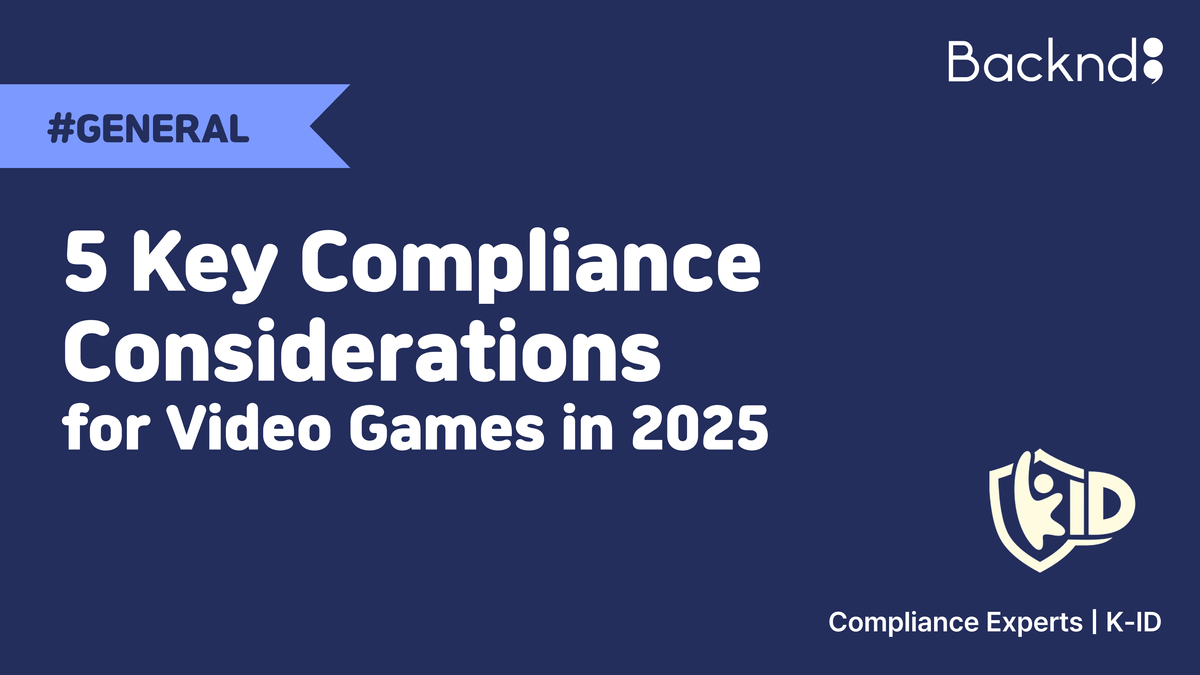5 Key Compliance Considerations for Video Games in 2025

Introduction
As online gaming continues to grow, so too does the complexity of compliance with child safety and data privacy laws. Regulations such as COPPA(Children's Online Privacy Protection Rule) in the U.S., GDPR(General Data Protection Regulation) in Europe, and emerging laws across Asia and South America are forcing game developers to take proactive steps to ensure their platforms are safe and legally compliant.
As regulations continue to evolve, understanding compliance is essential for both child safety and business sustainability. Here are five key compliance considerations for video games in 2025.
** This article was largely prepared with the research and insights provided by K-ID
1. Defining "Child" is More Complicated Than You Think
When developing a game with compliance in mind, the first question to answer is: What is a child?
Legally, a "child" is someone below the Age of Digital Consent, which varies by country. For example:
- U.S.: 13 years old (COPPA)
- UK & EU: 13–16 years old (GDPR, varies by country)
- Japan: 18 years old (with some variations at 20 for adulthood)
Even within a single jurisdiction, different regulatory frameworks may apply to different age groups. While some laws focus on younger children, many new regulations are extending protections to teens, adding further complexity for game developers.
Developers must ensure their games can adapt to multiple definitions of "child" depending on the player's location.

2. Even If Your Game Isn't "For Kids," It May Still Need to Comply
Many developers believe that only "kids' games" need to follow child safety laws. This is a dangerous misconception.
Under COPPA and similar laws, an online service is considered "child-directed" if it is likely to appeal to children, even if the publisher did not intend for it to be played by kids.
For example:
- TikTok was fined under COPPA because many users were under 13, despite not being a "kids' app."
- Games with cartoonish graphics, bright colors, or pop-culture references popular with children can be flagged as "child-directed," even if they feature violence or other kid-unfriendly content (e.g., guns in Fortnite)
- Genshin Impact from Hoyoverse, was rated as 13+, but was still deemed to be ‘child-directed’ in 2025 due to the presence of “cute” characters, per the recent FTC action.
Even if a game is not designed for kids, developers must monitor their actual audience and enforce age restrictions or risk being held accountable under child protection laws.
3. Compliance is a Global Issue, Not Just a U.S. Concern
Many developers assume that compliance is just about COPPA in the U.S. or GDPR in Europe. However, regulations are rapidly emerging worldwide.
For instance:
- Thailand, Egypt, and Bangladesh have introduced new digital safety regulations.
- India’s Digital Personal Data Protection Act (2023) is expected to impact how global games operate in the region.
- And then the EU has laws that vary by member state,
- Finally, even in the U.S., some states operate on different legal standards that are stricter than the federal COPPA requirements.
Additionally, enforcement is increasing globally. Fines for child safety violations have skyrocketed from $200M before 2022 to over $2B since 2023, with Epic Games' Fortnite as one example of a game company facing major penalties. As recently as January 2025, Genshin Impact was the subject of a large fine by the FTC in the United States.
Simply complying with COPPA or GDPR is no longer enough—game developers must consider compliance on a global scale.
4. It’s Not Just About Game Content Anymore
Historically, game compliance was about content ratings managed by organizations like ESRB (U.S.), PEGI (Europe), and CERO (Japan) - & of course GRAC in Korea. Now, regulators are expanding their scope , resulting in in-game features such as payments, chat, data-usage etc, being scrutinized just as much as content.
Key areas of concern include:
- Chat & Friends Lists – Many jurisdictions require chat features to default to off for both kids as well as teens.
- Usernames & Avatars – These can be considered personal data under certain laws.
- In-Game Purchases & Loot Boxes – Highly regulated for kids and adults in regions like the EU, US, Australia, and Middle East due to concerns over gambling-like mechanics.
- Advertising – Using children's data for targeted ads is a major legal risk.
- Augmented/Virtual Reality – The collection of biometric data (such as facial tracking or movement patterns) is under increased scrutiny.
- Artificial Intelligence – regulators in the US and EU are particularly concerned both about the use of user data to train algorithmic models, and privacy/safety concerns related to the output of these models.
Game developers must audit their entire game beyond just content to ensure compliance with these new regulatory concerns.
5. “Self-Declared Age” May Be Shifting To “Age Assurance”
For years, developers relied on self-declared ages (simple age gates) to comply with age restrictions. However, regulators worldwide are moving towards more robust age verification methods.
New laws are requiring developers to prove a player's age using one of the following methods:
- Age Verification (ID-based checks) – Requiring government-issued ID, credit card verification, or other official documentation.
- Age Assurance (Facial Age Estimation) – Using AI-driven facial scanning to estimate a user's age without storing biometric data.
Facial age estimation is already becoming mandatory in over 40 jurisdictions, including the UK and parts of the EU. The U.S. is considering similar requirements, but note that many of these laws are being challenged in the U.S. court system for being overly restrictive or requiring the collection or processing of overly sensitive personal data. The success of these challenges to date simply underscores how important it is that any age assurance/verification method be as safe, effective, and privacy-preserving as possible.
Game developers must begin implementing secure, privacy-conscious age verification solutions to stay ahead of these regulations.
Final Thoughts: Compliance is an Ongoing Process
The reality is that compliance is not a one-time effort. Laws are constantly evolving, and governments worldwide are becoming more aggressive in enforcement.
The reality is that compliance is not a one-time effort. Laws are constantly evolving, and governments worldwide are becoming more aggressive in enforcement.
As the online landscape continues to change, developers must proactively integrate compliance measures into their games. There are various industry solutions available to address these challenges, such as K-ID(https://www.k-id.com/) and others.
These solutions can help navigate evolving regulations, allowing developers to focus on building great games while staying compliant.
Protecting kids online is not just a legal requirement—it’s a shared responsibility in the gaming industry to create a safer environment for everyone!

© 2025 AFI, INC. All Rights Reserved. All Pictures cannot be copied without permission.

![[External Essay] Gamescom 2025 Interactions](/content/images/size/w600/2025/09/------1.png)


